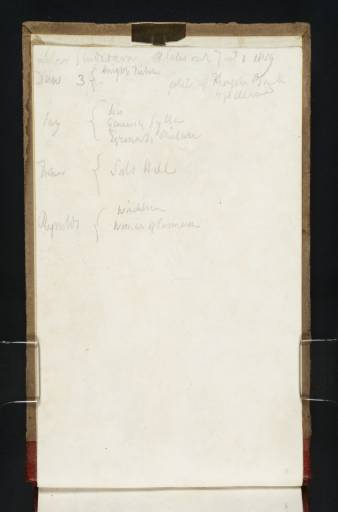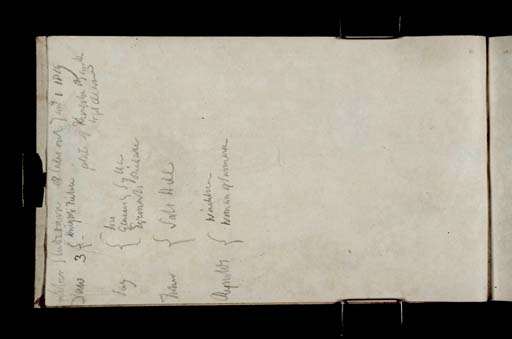Joseph Mallord William Turner Inscription by Turner; Notes Relating to the 'Liber Studiorum' 1818
Image 1 of 2
Joseph Mallord William Turner,
Inscription by Turner; Notes Relating to the 'Liber Studiorum'
1818
Joseph Mallord William Turner 1775–1851
Folio 2 Verso:
Inscription by Turner; Notes Relating to the ‘Liber Studiorum’ 1818
D11998
Turner Bequest CLIII 2a
Turner Bequest CLIII 2a
Pencil on white wove paper, 185 x 111 mm
Inscribed by Turner in pencil (see main catalogue entry)
Watermarked ‘[AL]LEE | [18]13’
Inscribed by Turner in pencil (see main catalogue entry)
Watermarked ‘[AL]LEE | [18]13’
Accepted by the nation as part of the Turner Bequest 1856
References
1909
A.J. Finberg, A Complete Inventory of the Drawings of the Turner Bequest, London 1909, vol.I, p.434, CLIII 2a.
1938
Martin Hardie, The Liber Studiorum Mezzotints of Sir Frank Short, R.A., P.R.E. after J.M.W. Turner, R.A. Catalogue & Introduction, London 1938, p.14.
1983
John Gage, Jerrold Ziff, Nicholas Alfrey and others, J.M.W. Turner, à l’occasion du cinquantième anniversaire du British Council, exhibition catalogue, Galeries nationales du Grand Palais, Paris 1983, pp.94–5, no.32.
1987
John Gage, J.M.W. Turner: ‘A Wonderful Range of Mind’, New Haven and London 1987, p.139.
1996
Gillian Forrester, Turner’s ‘Drawing Book’: The Liber Studiorum, exhibition catalogue, Tate Gallery, London 1996, pp.31, 141, 160 (nos.73, 74, 77, 87, 90).
Turner’s inscription reads:
Liber Studiorum Plates out Jany 1 1819
{Knight’s Picture
Daw 3 { plate of Kingston Bank
{ to get cleaned
Daw 3 { plate of Kingston Bank
{ to get cleaned
{Isis
Say {Glaucus & Scylla
{Egremont’s Picture
Turner {Salt Hill
Say {Glaucus & Scylla
{Egremont’s Picture
Turner {Salt Hill
{Winchelsea
Reynolds {Woman of Samaria
{ ’
Reynolds {Woman of Samaria
{ ’
This is a list of plates for Turner’s intermittent series illustrating types of landscape, the Liber Studiorum,1 which he appears to have been intending to issue on 1 January 1819. The note is evidently one of intention rather than deed, for only three of the eight listed were actually published on that day (together with two others not mentioned here) while the remaining five were never published at all.
The references are identifiable as follows:
‘Egremont’s Picture’ is identifiable as Apullia in Search of Appullus, engraved by Say6 but not published; no drawing is known.
David Hill
June 2009
Gillian Forrester, ‘Liber Studiorum’ in Evelyn Joll, Martin Butlin and Luke Herrmann (eds.), The Oxford Companion to J.M.W. Turner, Oxford 2001, pp.166–9.
Ibid., pp.133–4 no.72. The designation ‘Egremont’s Picture’ stems from Turner’s composition being derived from a picture by Claude in Lord Egremont’s Collection at Petworth. Finberg mistakenly connected the reference to a plate of Narcissus and Echo (Forrester 1996, p.156 no.90), which is based on a Turner painting owned by Lord Egremont, but only etched proofs of that plate are known, and William Say had no known hand in it.
How to cite
David Hill, ‘Inscription by Turner; Notes Relating to the ‘Liber Studiorum’ 1818 by Joseph Mallord William Turner’, catalogue entry, June 2009, in David Blayney Brown (ed.), J.M.W. Turner: Sketchbooks, Drawings and Watercolours, Tate Research Publication, September 2014, https://www


